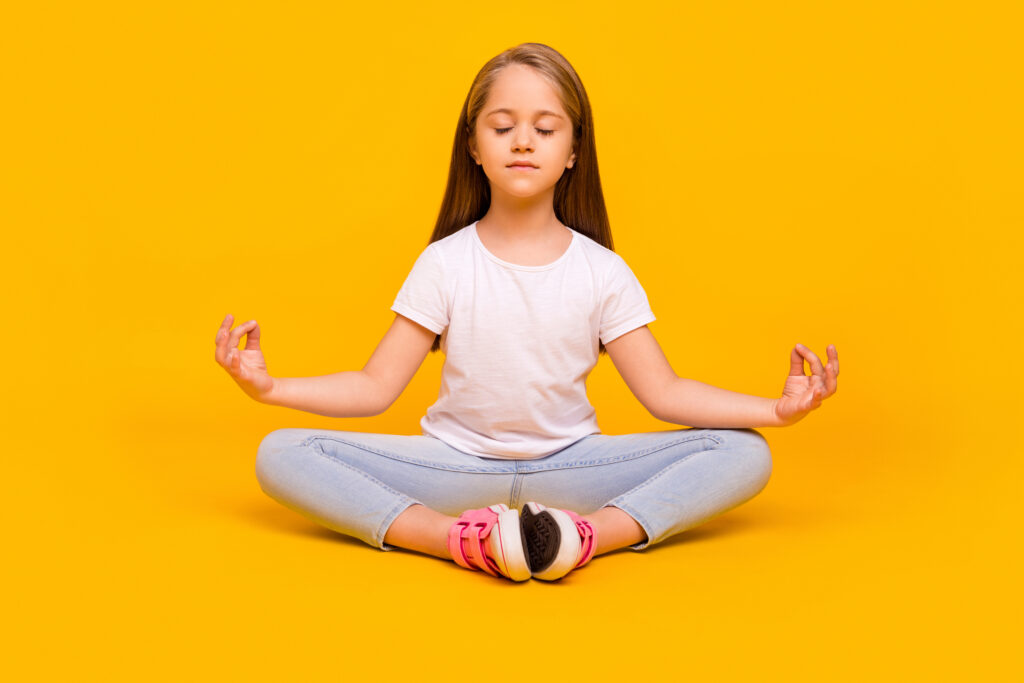3 Strong Ways to Build Mindfulness & Emotional Regulation at Home 🧘♀️

Mindfulness isn’t just for grownups. In fact, introducing mindfulness to children early can help them develop emotional awareness, focus, and resilience—skills that benefit both language learning and life.
Research shows that even simple mindfulness practices can improve children’s well-being and help them better manage stress and emotions (Semple et al., 2010). When paired with language-rich activities, mindfulness also gives kids new ways to express and understand their feelings.
Here’s a guide to teaching mindfulness and emotional regulation at home—with practical ideas you can start using today.
Why Mindfulness Matters for Kids
Mindfulness is the ability to pay attention to the present moment with curiosity and without judgment. For children, it’s often taught through playful activities that build:
🌟 Emotional regulation — learning to pause before reacting
🌟 Attention and focus — better concentration in learning
🌟 Empathy and kindness — important for social skills
🌟 Stress management — useful in an increasingly busy world
A meta-analysis of school-based mindfulness programs found consistent positive effects on children’s attention, emotional regulation, and well-being (Zenner et al., 2014). And these benefits carry over into language learning, too. A calm, focused mind learns better!
Mindfulness also helps children grow the capacity to notice and label their inner experiences—an essential foundation for developing rich emotional language. When children can express their feelings clearly, they build confidence and emotional intelligence.
3 Ways to Build Mindfulness Into Family Life
1️⃣ Start with the Breath
The Research:
Simple breath-based mindfulness practices can reduce anxiety and increase attention in children (Creswell, 2017).
What to Do:
🌼 Try a “bubble breath” activity. Ask your child to imagine blowing a giant bubble with their breath—slowly inhaling through the nose, then exhaling gently through the mouth to “blow the bubble.”
🌼 Practice during calm moments first, so it becomes a familiar tool during times of stress.
Why it works:
Breathing slows the nervous system and teaches kids they can use their breath to feel calm and grounded. It builds body awareness and gives children a simple tool they can use anytime.
When to use it:
Before bedtime, during transitions, after big emotions, or when your child feels frustrated.
2️⃣ Practice Naming Emotions
The Research:
Teaching children to label emotions enhances their emotional understanding and helps with self-regulation (Denham et al., 2012).
What to Do:
🌼 Create an “emotions board” with pictures of faces showing different feelings (happy, sad, angry, calm, excited).
🌼 During moments of strong emotion, help your child name their feeling: “I feel sad.” “I feel proud.” “I feel excited.”
🌼 Model this yourself: “I feel proud when you help clean up!” or “I feel a little tired today.”
Why it works:
Naming emotions helps kids process them rather than act them out. When children have the words for their inner experiences, they feel more understood—and more in control. It also grows their emotional vocabulary naturally.
Bonus tip:
Integrate emotional words into story time. Pause and ask: “How is this character feeling?” Encourage your child to answer and elaborate.
3️⃣ Build Mindful Moments Into Daily Routines
The Research:
Mindfulness doesn’t need to be taught in long lessons—short, frequent practice is most effective for young children (Semple et al., 2010).
What to Do:
🌼 Morning mindful moment: At breakfast, take one minute to notice sounds, smells, and tastes. Ask: “What do you hear? What do you smell? What does this taste like?”
🌼 Nature walk: Go outside and explore using the senses: “I see something green.” “I hear a bird.” “I feel the breeze.”
🌼 Gratitude at bedtime: Share one thing you’re grateful for and ask your child to do the same.
Why it works:
Short, playful practices fit naturally into busy family life. They help kids stay connected to the present moment and foster a positive, open mindset. Over time, these tiny moments of mindfulness build inner calm, resilience, and emotional balance.
Bonus tip:
Create a simple “mindfulness basket” with calming objects—smooth stones, a feather, a small bell, a calming picture book. Let your child choose an item and explore it mindfully.
Mindfulness + Language Learning = A Perfect Match
Mindfulness helps kids develop the focus and emotional flexibility they need to thrive as learners. It also provides a natural context for using rich emotional and sensory language. Mindfulness becomes a playful way to build vocabulary while helping kids grow as whole people.
And remember: you don’t have to be a mindfulness expert! Simply modeling calm breathing, emotional language, and moments of reflection is a wonderful start. A few mindful minutes each day can make a big difference.
References
- Creswell, J. D. (2017). Mindfulness Interventions. Annual Review of Psychology, 68, 491–516. Link Here
- Denham, S. A., Bassett, H. H., & Zinsser, K. (2012). Early childhood teachers as socializers of young children’s emotional competence. Early Childhood Education Journal, 40(3), 137–143. Link here
- Zenner, C., Herrnleben-Kurz, S., & Walach, H. (2014). Mindfulness-based interventions in schools—a systematic review and meta-analysis. Frontiers in Psychology, 5, 603. Link Here
🌟 For more engaging learning ideas, visit our blog weekly! We share creative activities, language tips, and more to make learning exciting. Stay connected with the latest posts on the Langmobile blog! And don’t forget to check out awesome songs on our Apple Music, YouTube, and Spotify pages to help with your language learning!

